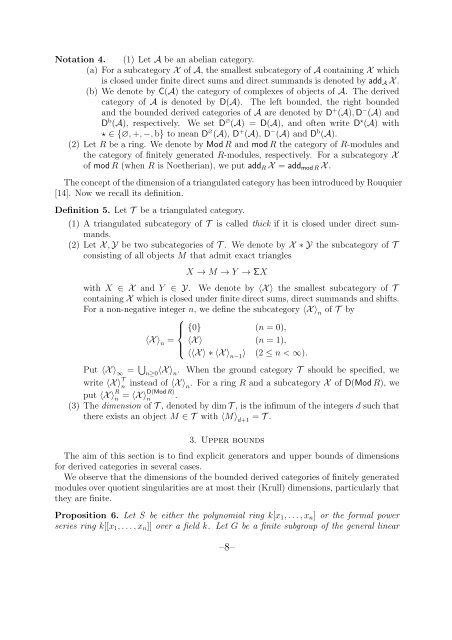Takuma Aihara
Takuma Aihara
Takuma Aihara
You also want an ePaper? Increase the reach of your titles
YUMPU automatically turns print PDFs into web optimized ePapers that Google loves.
Notation 4. (1) Let A be an abelian category.(a) For a subcategory X of A, the smallest subcategory of A containing X whichis closed under finite direct sums and direct summands is denoted by add A X .(b) We denote by C(A) the category of complexes of objects of A. The derivedcategory of A is denoted by D(A). The left bounded, the right boundedand the bounded derived categories of A are denoted by D + (A), D − (A) andD b (A), respectively. We set D ∅ (A) = D(A), and often write D ⋆ (A) with⋆ ∈ {∅, +, −, b} to mean D ∅ (A), D + (A), D − (A) and D b (A).(2) Let R be a ring. We denote by Mod R and mod R the category of R-modules andthe category of finitely generated R-modules, respectively. For a subcategory Xof mod R (when R is Noetherian), we put add R X = add mod R X .The concept of the dimension of a triangulated category has been introduced by Rouquier[14]. Now we recall its definition.Definition 5. Let T be a triangulated category.(1) A triangulated subcategory of T is called thick if it is closed under direct summands.(2) Let X , Y be two subcategories of T . We denote by X ∗ Y the subcategory of Tconsisting of all objects M that admit exact trianglesX → M → Y → ΣXwith X ∈ X and Y ∈ Y. We denote by 〈X 〉 the smallest subcategory of Tcontaining X which is closed under finite direct sums, direct summands and shifts.For a non-negative integer n, we define the subcategory 〈X 〉 nof T by⎧⎪⎨ {0} (n = 0),〈X 〉 n= 〈X 〉 (n = 1),⎪⎩〈〈X 〉 ∗ 〈X 〉 n−1〉 (2 ≤ n < ∞).Put 〈X 〉 ∞= ∪ n≥0 〈X 〉 n. When the ground category T should be specified, wewrite 〈X 〉 T ninstead of 〈X 〉 n. For a ring R and a subcategory X of D(Mod R), weput 〈X 〉 R R)n= 〈X 〉D(Modn.(3) The dimension of T , denoted by dim T , is the infimum of the integers d such thatthere exists an object M ∈ T with 〈M〉 d+1= T .3. Upper boundsThe aim of this section is to find explicit generators and upper bounds of dimensionsfor derived categories in several cases.We observe that the dimensions of the bounded derived categories of finitely generatedmodules over quotient singularities are at most their (Krull) dimensions, particularly thatthey are finite.Proposition 6. Let S be either the polynomial ring k[x 1 , . . . , x n ] or the formal powerseries ring k[[x 1 , . . . , x n ]] over a field k. Let G be a finite subgroup of the general linear–8–















